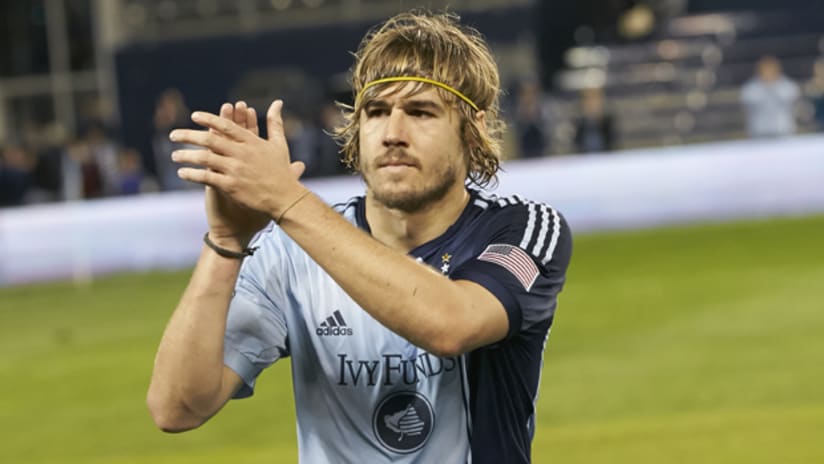May 23, 2014.
He thought his ankle had been kicked from behind. But when he glanced over his back after he fell to the ground, nobody was there.
Chance Myers was shoulder-to-shoulder with Jermain Defoe, chasing a loose ball near the Toronto FC bench. Then it happened—damage done in a split-second that would take so much longer to repair.
Everything below Myers’ left calf went numb as 20,000 fans fell silent at Sporting Park. His heart raced as he reached for the tingling sensation with his hand. His fingers felt the touch; his ankle didn’t.
Adrenaline masked any discernable pain as Myers was taken to a treatment table in the locker room. Catching a glimpse of the big-screen TV nearby, his first emotion was anger: seeing his teammates finish the remainder of the first half without him didn’t sit well.
He would grow used to it in the coming days, weeks and months.
Head Athletic Trainer Kenny Ishii and an on-site doctor briefly examined his ankle and had little doubt: the Achilles had probably ruptured. Myers had joined an injury list that would eventually stretch too long for the team to overcome by season’s end.
Ever since that hot, humid evening more than a year ago, Sporting Kansas City has played 44 straight games without one if its best defenders and most respected leaders.
But on Tuesday, there’s a good possibility that Myers, the team’s longest tenured player, will see competitive action for the first time in 389 days.
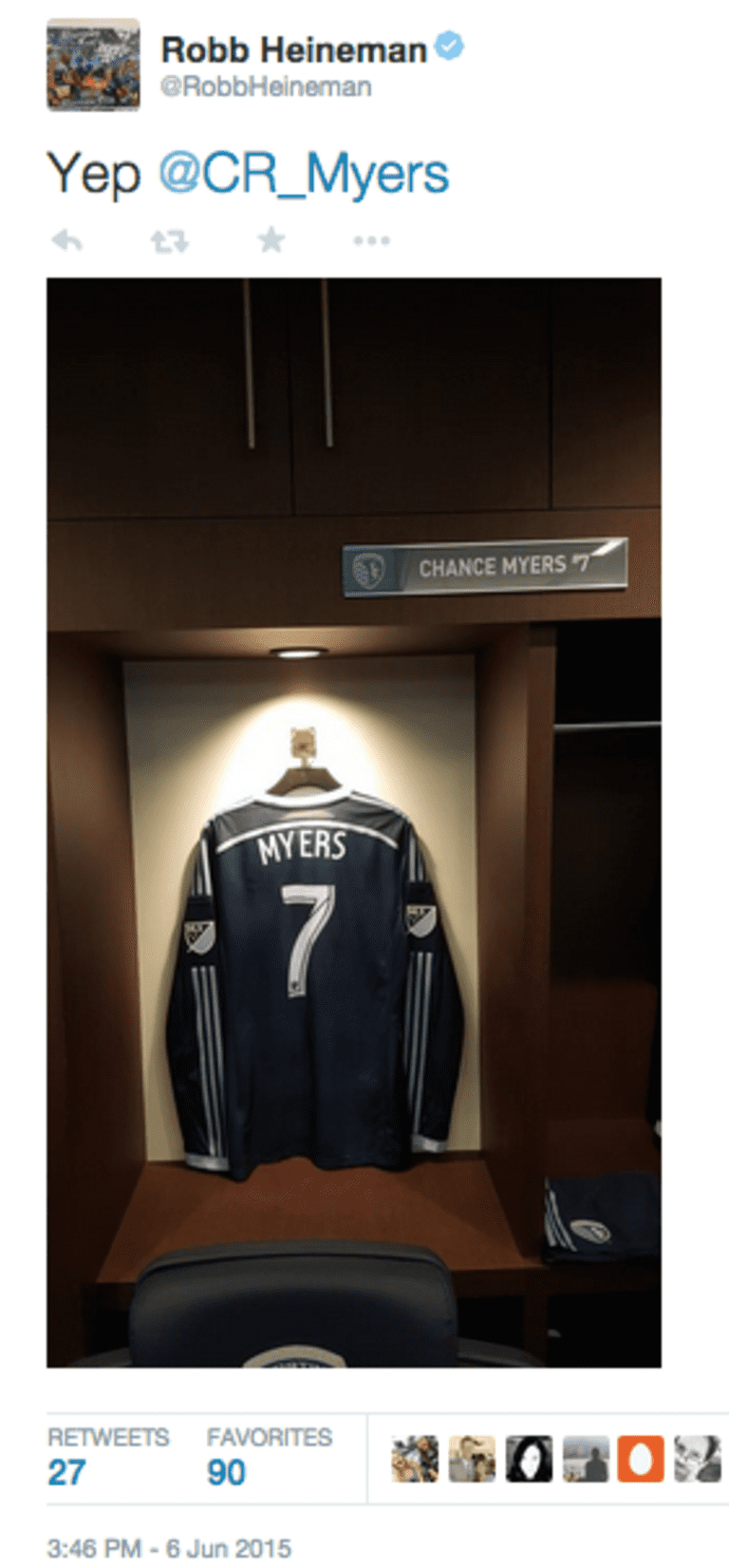
The journey has been a supreme test of patience and mental fortitude. He describes it as the most difficult chapter of his professional career—no small statement from an eighth-year MLS veteran whose first three seasons were riddled by injury and illness.
“With this injury, there were a lot of periods where you felt like you just weren’t going to get better,” Myers said. “It would take so long to get over a small hill. And once you got over that small hill, you realized there was still so far to go.”
Tuesday’s U.S. Open Cup match against Saint Louis FC may well be the top of the proverbial mountain. Myers, 27, started from the bottom more than a year ago. Now, he is on the brink of a much-anticipated return to the Sporting Park pitch.
“Anybody who’s been through something like this can attest that you get a new appreciation for being able to play the game you love,” Myers said. “When it’s taken away from you, you either walk away from the challenge or you can fight even harder to get it back.
“There’s nothing easy about it. But you watch your best friends competing without you on a daily basis for so long, and if that’s not fueling your fire, nothing will.”
For almost 13 months now, Myers has battled to regain full fitness in hopes of reaching the heights of 2011-2013, when he was one of Major League Soccer’s best right backs. He eclipsed 30 starts across all competitions in each of those seasons and helped Sporting KC concede fewer goals than any other club during that time. A constant threat down the right flank, he also led the league with 91 successful open-play crosses over the three-year period and was the highest-rated outside back in the 2013 MLS Castrol Index.
“There’s no doubt to me that Chance is still one of the best outside backs in the league,” manager Peter Vermes said after training on Monday. “Now it’s just about him getting rhythm and getting games.”
Full recovery took longer than Myers would have liked, of course. For someone as determined to push the envelope as him, the baby-step approach was never easy to tolerate. But that will do nothing to lessen his excitement the next time he steps onto the field clad in Sporting blue—especially given how bleak things were a year ago.
“I never had a doubt in my mind that I’d be back playing again,” Myers said. “But knowing the length of the injury and what the comeback required, it was one of the hardest-hitting experiences I’ve ever had.”
* * *
The Achilles is the thickest and strongest tendon in the human body.
Attaching the calf muscle to the heel bone, it plays a vital role in just about every practical leg movement—from walking to sprinting and jumping. An athlete’s running speed and power generation hinges on the Achilles’ ability to sustain large loads of stress, sometimes up to eight times one’s body weight when competing at high intensities.
It’s obvious, then, why the “Achilles heel” moniker is synonymous with vulnerability. Any severe harm to the tendon can render one’s superior strength, speed and stamina useless. A split-second rupture can spell the end of an athlete’s career or require several months of rigid, oftentimes painful rehabilitation.
Then there’s emotional toll of such a long, unpredictable path to recovery. Separation from the team—from day-to-day competition, from the thrill of winning and the sting of losing—can be the most agonizing part.
Myers tried to keep all of that out of his mind during the 48 hours after his injury. Maybe, he thought, the injury wasn’t as bad as the doctors thought. He hoped for the best but braced for the worst, and MRI results delivered the latter: he had sustained a ruptured Achilles tendon and would miss the rest of the season.
Confined to crutches with his lower left leg wrapped in a cast, Myers felt worst during the few weeks after his May 28 surgery. The prospect of sitting out all of 2014, and possibly more, evoked sour memories of his start in Kansas City.
Drafted No. 1 overall as a Generation adidas signing in the 2008 MLS SuperDraft out of UCLA, Myers was limited to just 10 MLS matches his rookie year due to a long bout with mononucleosis. He broke his toe the following preseason and made just six league appearances in 2009. A hamstring injury caused him to miss half of 2010.
This was the toughest setback of them all.
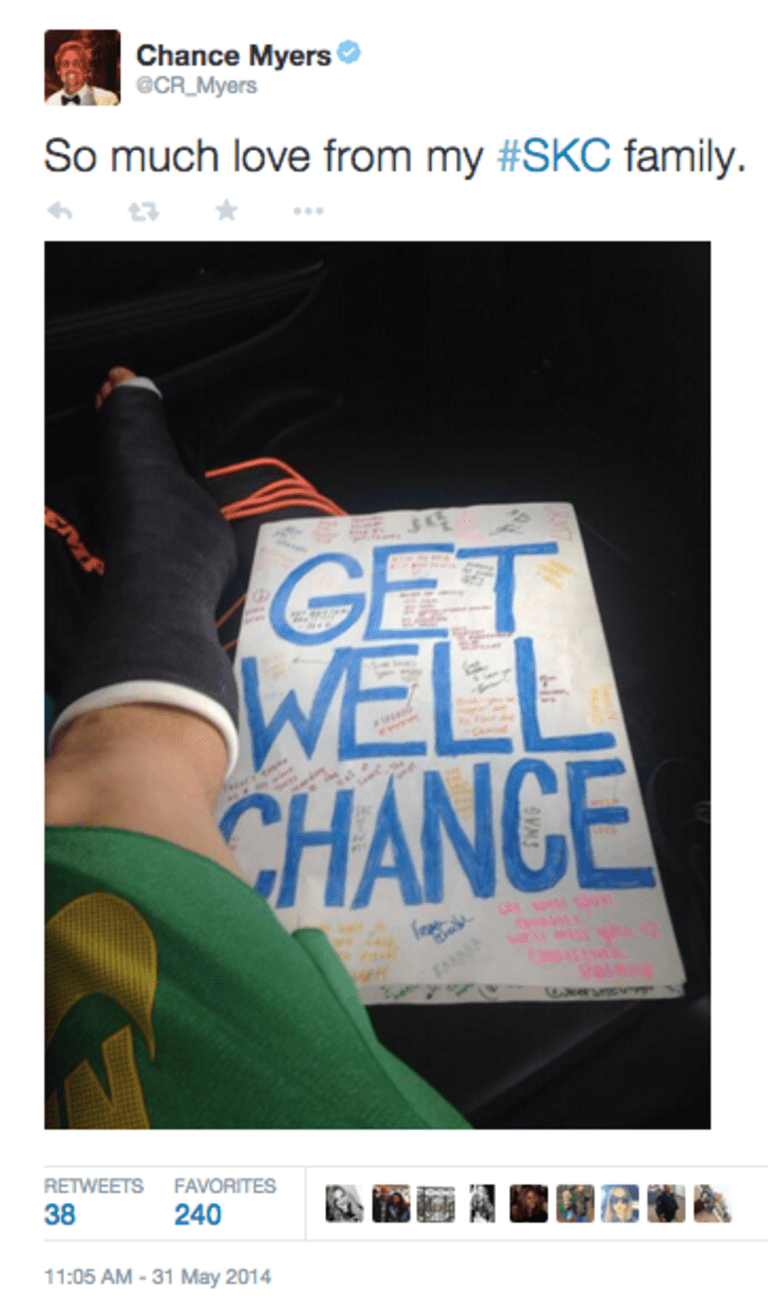
“Suddenly it was tons of trouble to do all these simple things,” Myers said. “I couldn’t roll around in bed. Going to the bathroom was a trip. I was just down in the dumps knowing I was such a long way away from playing again.”
Thanks to visits from teammates and round-the-clock care from his girlfriend and parents—who had flown in from his hometown of Thousand Oaks, California—Myers never sunk too low. He also received dozens of encouraging phone calls, texts and social media messages from friends and fans.
“The hill is so steep with this type of injury that you can get lost if you don’t have the right support system,” Myers said. “That was key for me, especially early on when I was feeling the worst.
“Obviously I try to have a tough mentality and usually I don’t want to be emotional. That was definitely the case before this injury happened. I never wanted to have to ask for help. But one of my biggest gains out of this experience is learning to use my supporting cast. I have always been hesitant to do that because when everything’s going well, you don’t think you need them. But this time I really needed them, and they were always there.”
* * *
No day was the same, but the grind was never-ending.
As the calendar turned to July, Myers had his bulky cast removed and began a meticulous rehab program that would push his physical and mental resolve to the limit. He remembers arriving to Swope Soccer Village at 8 a.m. each day. After that, the monotony becomes a blur.
There was laser therapy, where a small electronic device was wrapped around his ankle to reduce swelling. There was electronic stimulation therapy, where a machine sent electric impulses through his ankle to help develop muscle. There were various muscle exercises, usually done in sets of high reps for up to an hour at a time—single leg squats, calf raises, hip adductors, isometric groin contractions and much more.
“The good thing about rehab is you find ways to push yourself to limits you can’t really fathom going, so it was just cool to compete every day and make it a competition within myself,” Myers recalled. “Kenny would always try to push me and I’d try to prove him wrong. He’d say ‘You can’t do that.’ Well, I’ll show you.”
Myers never needed to look far for motivation or inspiration. Oftentimes it was right there next to him.
During most of the rehab process, he was side-by-side with another Sporting defender who was fighting just as hard to heal a serious ankle injury—centerback Ike Opara. Throughout 2014 and into 2015, they were the first players to arrive at Swope and the last players to leave.
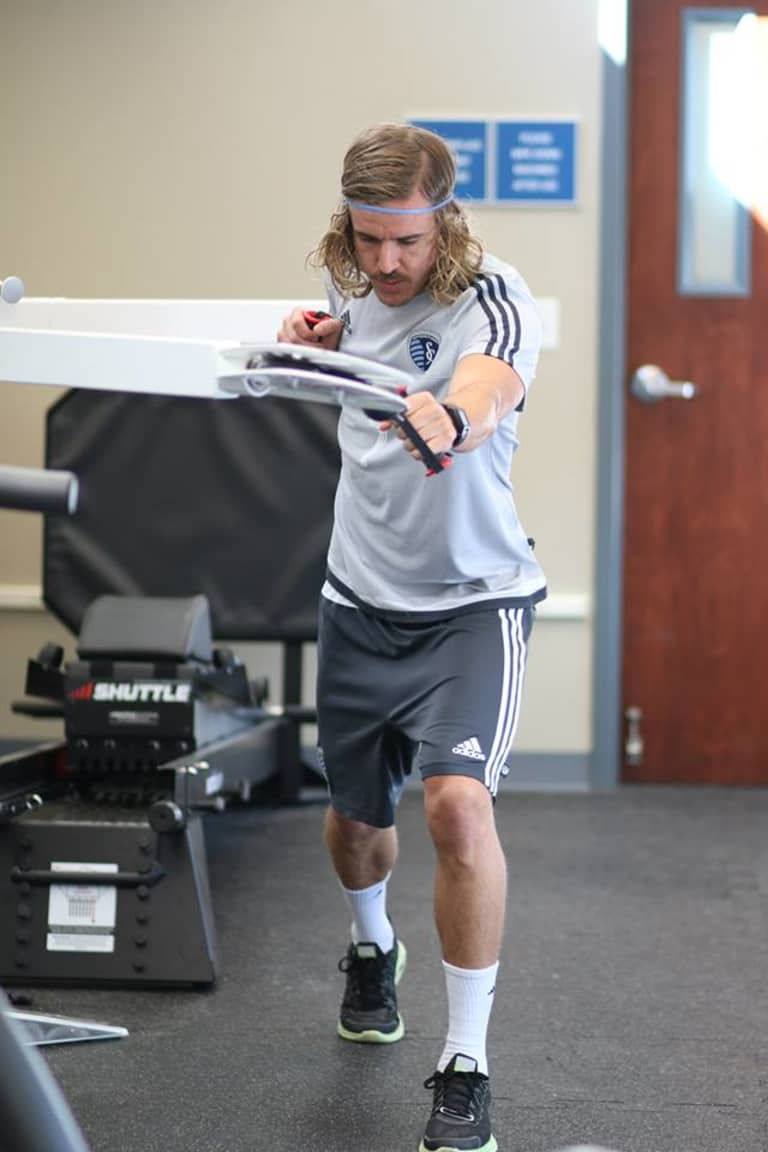
“Chance and Ike have been extremely committed and their attitude has been excellent,” Ishii said. “Their days have been very long because they’re doing a lot of things. As an athletic trainer, I need to make sure they are making good progress physically but also in a good mindset.”
In order to do that, Ishii implemented a sufficient amount of rest time—at least one day off per week to recharge physically and mentally—and made a conscious effort to give Myers and Opara weekly milestones to reach. The end result was a feeling of satisfaction.
“Once I could start pinpointing the progress being made, that’s when things started clicking for good,” Myers said. “There was never a huge gain all at once. It was very incremental, so I just had to focus on those small gains. It took a while to get in tune with that, but once I did, it flipped a mental switch for me.”
The biggest milestones provoked the most excitement. Myers began running in November, shortly after Sporting KC was eliminated from the playoffs. He began light field exercises in December, then sprinting and cutting in February.
The most exhilarating milestone was his return to full-contact training sessions in early spring. Myers says he has been the happiest person on the training ground ever since.
“After not being a able to touch grass for awhile, it’s extremely refreshing to be able to go out there and just play. I remember the moment when somebody hit me for the first time [during scrimmage]. I smiled and laughed and just thought, ‘All right, this is what I love to do.’”
If Myers had any doubts about being able to replicate the form he had captured from 2011-2013, they vanished when he saw the emphatic return Opara made after missing most of 2014 with a chondral defect in his right ankle. Nearly a year passed between MLS appearances for Opara, but he made up for lost time in March by scoring twice, leading the league in interceptions and earning an MLS Player of the Month nomination.
“Ike knows what it’s like to be on the brink of a serious injury and then coming back to play at the highest level,” Myers said. “That’s the perfect aspiration for me—the way he came back from a long injury and played arguably the best he’s played in his whole career. It motivates me to do just the same.”
* * *
The water was his escape.
When tedious rehab provoked frustration, when improvement was too minimal to notice, when being away from the sport he loved burned too deep, the swimming pool was liberating.
Take, for instance, one morning at the end of last October. While his teammates were in New York preparing for a win-or-go-home playoff game later that night, Myers had a 25-meter swim lane all to himself at a Kansas City-area fitness center.
Stroke after stroke, lap after lap, freestyle swimming was Myers’ therapeutic hobby. Between August and April, he spent three or four days a week and up to 90 minutes at a time in the pool.
“When I couldn’t run, couldn’t ride a bike, couldn’t do much at all to stay physically active, swimming was my release,” Myers said.
The physical benefits were obvious. Swimming kept Myers’ cardiovascular endurance high and helped him quickly regain the fitness required of a Sporting KC outside back when he returned to training.
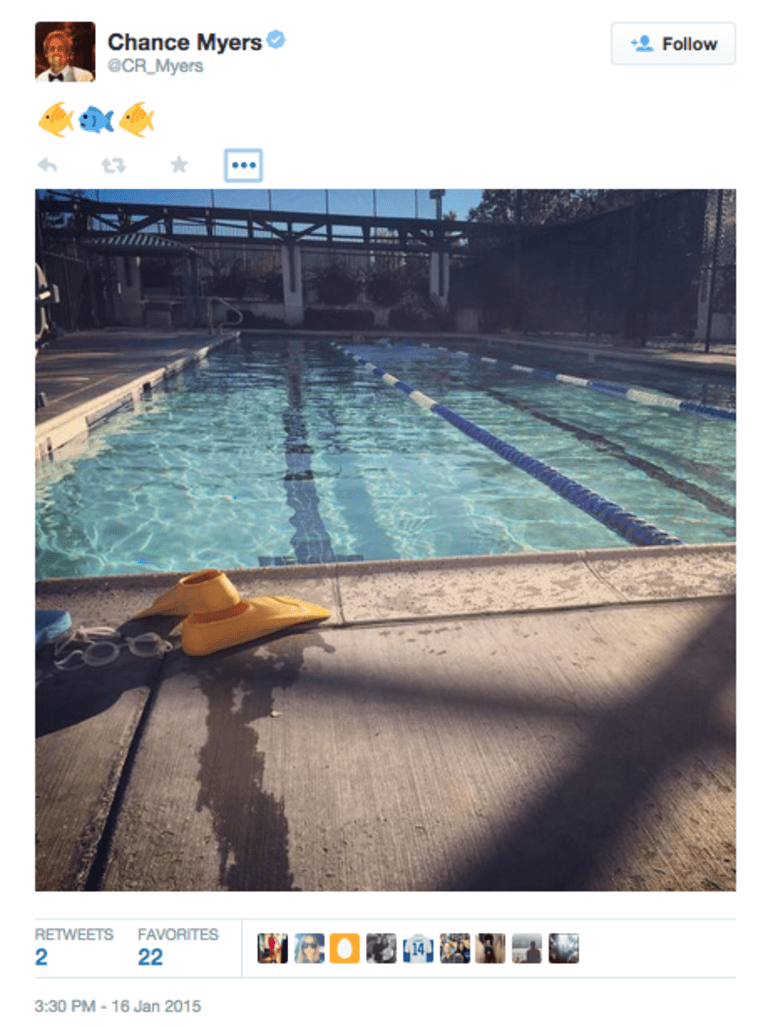
Just as beneficial was the mental boost that swimming provided. Growing up 15 miles from the Pacific Ocean in Thousand Oaks, California, Myers had always loved being around water. Swimming laps wasn’t exactly surfing on the beach, but he relished the aquatic workouts nonetheless. Some days were harder than others, but each exercise was cathartic, allowing Myers to compete with himself when he couldn’t compete on the field.
“Most guys would hate getting in the pool and doing a tough swim workout, but for me it’s the exact opposite,” Myers said. “I can’t get enough of it. It’s fun for me to get in the water, push myself and just lose track of time.”
Ishii’s rehab program never prescribed swimming, but he knew it would help Myers develop his aerobic capacity when he couldn’t jog, sprint or lift weights. Thus, he permitted Myers to implement water workouts into daily rehab activities.
The one caveat was moderation. If Myers had his way, he would swim anytime his ankle wasn’t sore. On more than one occasion, Ishii had to tell Myers to skip the aquatics and take a day off.
“Swimming was definitely something we had to control so that he wouldn’t overdo it,” Ishii said. “If his ankle was feeling good, we knew he was going to swim. There were a few times here and there where we had to hold him back. But that’s how his mindset was during rehab—fully committed and always wanting to improve.”
In a bid to return to the field in even better shape, Myers didn’t stop there. He also revamped his diet, eliminating soda, sugar, excess carbohydrates and junk foods he would occasionally eat in the past.
“When you’re out injured a long time, you want to do everything you possibly can to come back even stronger,” Myers said. “My lifestyle choices had always been good to begin with, but I just took it to a new level.”
Myers underwent a series of fitness tests in April, including the infamous “beep test” that tested his aerobic capacity and a vertical jump that tested his power. To the coaches’ delight, he hadn’t lost a second on the beep test nor an inch on the vertical jump. His body fat was under five percent, down from the eight or nine percent he had during most of his pro career.
“At that point, Chance was probably fitter than some of the guys who were playing in games,” Ishii said. “Then it just became a process of him becoming a soccer player again, and that takes a little more time. We laid the foundation with rehab, and now he just needed to go through training with the team.”
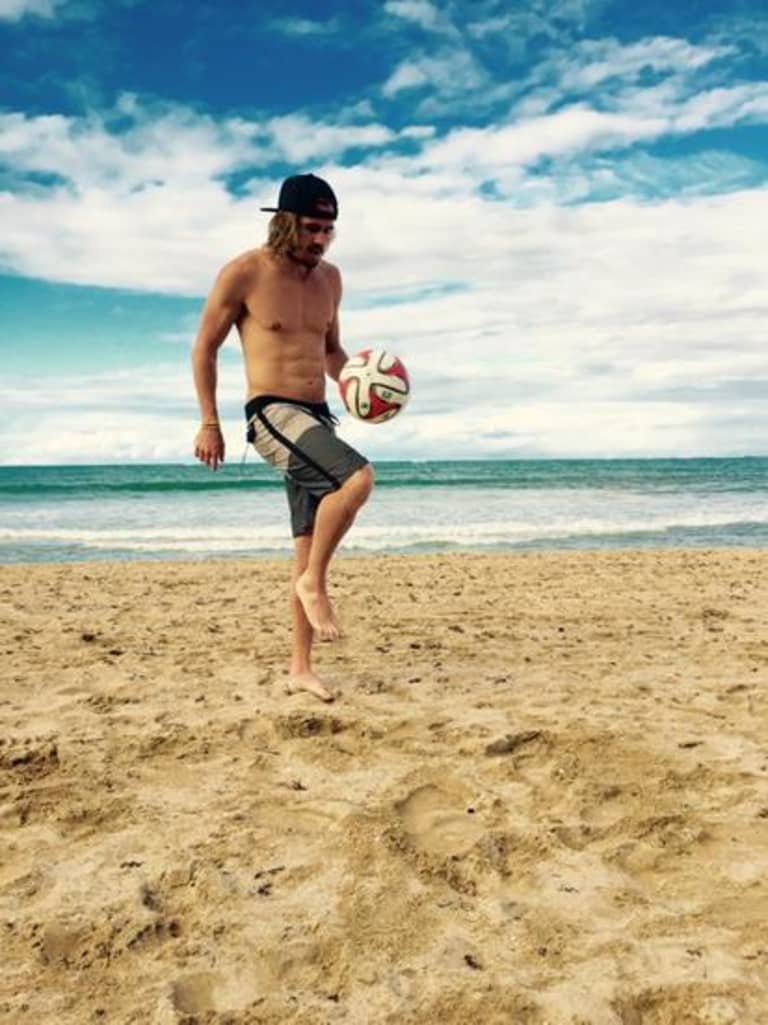
It would be easy to mistake Myers as the quintessential surfer. Long, flowing blonde hair drops to his shoulders. His easygoing personality matches the vibe of his native Southern California. If he has anything to say, he speaks at a relaxed pace.
Underneath the laid-back façade, however, lies a fierce competitiveness—one that Vermes believes the team has sorely missed for the past year.
“I think leadership is something that is maybe not used a lot when you mention Chance’s name, but for us his experience and leadership is something we’ve really needed for awhile.
“When Chance comes into the locker room, he’s not a quiet guy sitting in the corner, especially if things aren’t going well with the team. He’s a guy who isn’t full of a ton of words, but he’s full of words that really mean something. And guys listen.”
Vermes describes Myers as one of the most competitive players on the team. He watches every game after Sporting KC plays it, whether he features in the match or not. If he’s playing, he will look for the slightest imperfections to improve upon next time. If he’s sidelined—as has been the case since last May—he approaches teammates with coaching points afterward.
Consequently, Myers’ long-term absence has been felt in numerous ways. Losing a player of his caliber on the field is one thing. It’s another thing to lose a valued leader in the locker room, especially during road games when Myers didn’t’ travel with the team.
Vermes expects Sporting KC to receive a significant boost when Myers begins playing again, not only because of his ability to attack and defend.
“The other thing for him is the intangibles—the experience of being around here,” Vermes said. “He’s a very well respected guy within the group and he knows how to keep the group in a place where they have to stay competitive throughout the 90 minutes. That’s where he’s good. That’s where his presence makes a difference.”
At long last, Sporting KC may have that presence again when they host Saint Louis FC on Tuesday. It will mark the end of an arduous road to full health and the beginning of what he hopes is another successful stint as the starting right back for an MLS Cup contender.
But regardless of how the next chapter unfolds, Myers is simply thrilled to be back in the game. His teammates and coaches will be excited as well: a veteran leader is returning to the fold.
“People have told me I’ll be back better and stronger than before, and I’ve tried hard to take steps to do that,” Myers said. “But to be honest, whether that ends up being the case or not, I’m just happy to finally be back doing what I love to do.”

